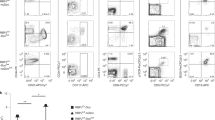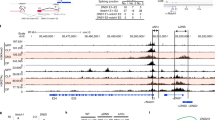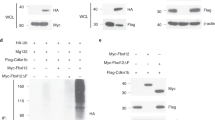Abstract
The current dogma is that the thymus is colonized by progenitors that retain the capacity to generate both T cells and B cells, and that intrathymic Notch signalling determines lineage choice so that T cells, rather than B cells, develop in the thymus. However, evidence is now accumulating to indicate that, at least during fetal life, this is not the case. Rather, it now seems that the fetal thymus is colonized by progenitors that have already made the T-cell versus B-cell lineage choice. We propose an alternative role for Notch signalling in the thymus, which is not to mediate this choice but instead to reveal it by supporting further T-cell differentiation in the thymic microenvironment.
This is a preview of subscription content, access via your institution
Access options
Subscribe to this journal
Receive 12 print issues and online access
$209.00 per year
only $17.42 per issue
Buy this article
- Purchase on Springer Link
- Instant access to full article PDF
Prices may be subject to local taxes which are calculated during checkout


Similar content being viewed by others
References
Petrie, H. T. Cell migration and the control of post-natal T-cell lymphopoiesis in the thymus. Nature Rev. Immunol. 3, 859–866 (2003).
Masuda, K. et al. Thymic anlage is colonized by progenitors restricted to T, NK, and dendritic cell lineages. J. Immunol. 174, 2525–2532 (2005).
Harman, B. C. et al. T/B lineage choice occurs prior to intrathymic Notch signaling. Blood 106, 886–892 (2005).
Radtke, F. et al. Deficient T cell fate specification in mice with an induced inactivation of Notch1. Immunity 10, 547–558 (1999).
Wilson, A., MacDonald, H. R. & Radtke, F. Notch 1-deficient common lymphoid precursors adopt a B cell fate in the thymus. J. Exp. Med. 194, 1003–1012 (2001).
Tanigaki, K. et al. Regulation of αβ/γδ T cell lineage commitment and peripheral T cell responses by Notch/RBP-J signaling. Immunity 20, 611–622 (2004).
Maillard, I. et al. Mastermind critically regulates Notch-mediated lymphoid cell fate decisions. Blood 104, 1696–1702 (2004).
Koch, U. et al. Subversion of the T/B lineage decision in the thymus by lunatic fringe-mediated inhibition of Notch-1. Immunity 15, 225–236 (2001).
Anderson, G., Pongrac'z, J., Parnell, S. M. & Jenkinson, E. J. Notch ligand-bearing thymic epithelial cells initiate and sustain Notch signaling in thymocytes independently of T cell receptor signaling. Eur. J. Immunol. 31, 3349–3354 (2001).
Schmitt, T., Ciofani, M., Petrie, H. T. & Zuniga-Pflucker, J. C. Maintenance of T cell specification and differentiation requires recurrent Notch receptor-ligand interactions. J. Exp. Med. 200, 469–479 (2004).
Kaneta, M. et al. A role for pref-1 and HES-1 in thymocyte development. J. Immunol. 164, 256–264 (2000).
Felli, M. P. et al. Expression pattern of Notch1, 2 and 3 and Jagged1 and 2 in lymphoid and stromal thymus components: distinct ligand-receptor interactions in intrathymic T cell development. Int. Immunol. 11, 1017–1025 (1999).
Pui, J. C. et al. Notch1 expression in early lymphopoiesis influences B versus T lineage determination. Immunity 11, 299–308 (1999).
Maillard, I., Fang, T. & Pear, W. S. Regulation of lymphoid development, differentiation, and function by the Notch pathway. Annu. Rev. Immunol. 23, 945–974 (2005).
Zweidler-McKay, P. A. et al. Notch signaling is a potent inducer of growth arrest and apoptosis in a wide range of B-cell malignancies. Blood 106, 3898–3906 (2005).
Porritt, H. E. et al. Heterogeneity among DN1 prothymocytes reveals multiple progenitors with different capacities to generate T cell and non-T cell lineages. Immunity 20, 735–745 (2004).
Balciunaite, G., Ceredig, R. & Rolink, A. G. The earliest subpopulation of mouse thymocytes contains potent T, significant macrophage, and natural killer cell but no B-lymphocyte potential. Blood 105, 1930–1936 (2005).
Tan, J. B., Visan, I., Yuan, J. S. & Guidos, C. J. Requirement for Notch1 signals at sequential early stages of intrathymic T cell development. Nature Immunol. 6, 671–679 (2005).
Sambandam, A. et al. Notch signaling controls the generation and differentiation of early T lineage progenitors. Nature Immunol. 6, 663–670 (2005).
Zediak, V. P., Maillard, I. & Bhandoola, A. Closer to the source: notch and the nature of thymus-settling cells. Immunity 23, 245–248 (2005).
Petrie, H. T. & Kincade, P. W. Many roads, one destination for T cell progenitors. J. Exp. Med. 202, 11–13 (2005).
Schwarz, B. A. & Bhandoola, A. Circulating hematopoietic progenitors with T lineage potential. Nature Immunol. 5, 953–960 (2004).
Benz, C. & Bluel, C. C. A multipotent precursor in the thymus maps to the branching point of the T versus B lineage decision. J. Exp. Med. 202, 21–31 (2005).
Katsura, Y. Redefinition of lymphoid progenitors. Nature Rev. Immunol. 2, 127–132 (2002).
Kawamoto, H., Ohmura, K. & Katsura, Y. Presence of progenitors restricted to T, B, or myeloid lineage, but absence of multipotent stem cells, in the murine fetal thymus. J. Immunol. 161, 3799–3802 (1998).
Ikawa, T., Kawamoto, H., Fujimoto, S. & Katsura, Y. Commitment of common T/natural killer (NK) progenitors to unipotent T and NK progenitors in the murine fetal thymus revealed by a single progenitor assay. J. Exp. Med. 190, 1617–1626 (1999).
Rodewald, H. R., Kretzschmar, K., Takeda, S., Hohl, C. & Dessing, M. Identification of pro-thymocytes in murine fetal blood: T lineage commitment can precede thymus colonization. EMBO J. 13, 4229–4240 (1994).
Arcangeli, M. L. et al. Extrathymic hemopoietic progenitors committed to T cell differentiation in the adult mouse. J. Immunol. 174, 1980–1988 (2005).
Lu, M. et al. The earliest thymic progenitors in adults are restricted to T, NK, and dendritic cell lineage and have a potential to form more diverse TCRβ chains than fetal progenitors. J. Immunol. 175, 5848–5856 (2005).
Harman, B. C., Jenkinson, E. J. & Anderson, G. Entry into the thymic microenvironment triggers Notch activation in the earliest migrant T cell progenitors. J. Immunol. 170, 1299–1303 (2003).
Zuniga-Pflucker, J. C. T-cell development made simple. Nature Rev. Immunol. 4, 67–72 (2004).
Varnum-Finney, B. et al. The Notch ligand, Jagged-1, influences the development of primitive hematopoietic precursor cells. Blood 91, 4084–4091 (1998).
Dallas, M. H., Varnum-Finney, B., Delaney, C., Kato, K. & Bernstein, I. D. Density of the Notch ligand Delta1 determines generation of B and T cell precursors from hematopoietic stem cells. J. Exp. Med. 201, 1361–1366 (2005).
Lehar, S. M., Dooley, J., Farr, A. G. & Bevan, M. J. Notch ligands Delta 1 and Jagged1 transmit distinct signals to T-cell precursors. Blood 105, 1440–1447 (2005).
Masuda, K. et al. Prethymic T-cell development defined by the expression of paired immunoglobulin-like receptors. EMBO J. 24, 4052–4060 (2005).
Maillard, I. et al. Notch-dependent T lineage commitment occurs at extrathymic sites following bone marrow transplantation. Blood 107, 3511–3519 (2006).
Hu, Q. D. et al. F3/contactin acts as a functional ligand for Notch during oligodendrocyte maturation. Cell 115, 163–175 (2003).
Suniara, R. K., Jenkinson, E. J. & Owen, J. J. T. An essential role for thymic mesenchyme in early T cell development. J. Exp. Med. 191, 1051–1056 (2000).
Acknowledgements
The work was supported by an MRC Programme Grant to E.J.J. and G.A.
Author information
Authors and Affiliations
Corresponding author
Ethics declarations
Competing interests
The authors declare no competing financial interests.
Rights and permissions
About this article
Cite this article
Jenkinson, E., Jenkinson, W., Rossi, S. et al. The thymus and T-cell commitment: the right niche for Notch?. Nat Rev Immunol 6, 551–555 (2006). https://doi.org/10.1038/nri1883
Issue Date:
DOI: https://doi.org/10.1038/nri1883
This article is cited by
-
Notch signaling pathway: architecture, disease, and therapeutics
Signal Transduction and Targeted Therapy (2022)
-
Initial seeding of the embryonic thymus by immune-restricted lympho-myeloid progenitors
Nature Immunology (2016)
-
Mammalian glycosylation in immunity
Nature Reviews Immunology (2008)
-
Itch: a HECT-type E3 ligase regulating immunity, skin and cancer
Cell Death & Differentiation (2008)
-
Launching the T-cell-lineage developmental programme
Nature Reviews Immunology (2008)



